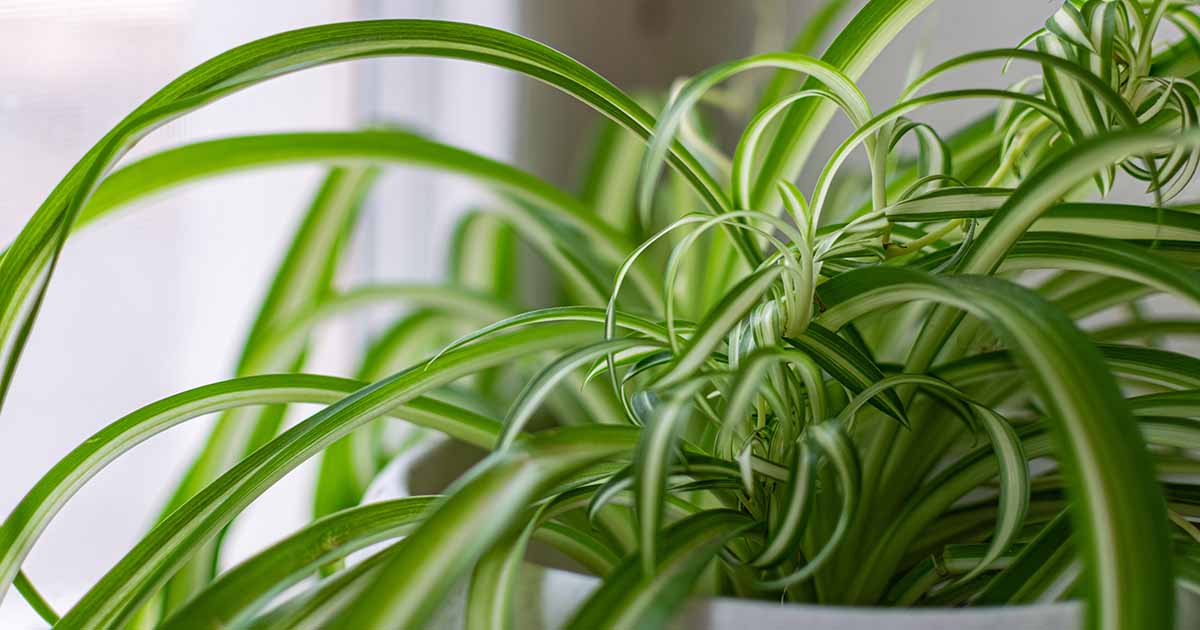I love my spider plants, and part of the reason is that they need very little attention from me to grow well.
With their strappy leaves and cute spiderettes, Chlorophytum comosum make fun, low-maintenance houseplants that almost seem to thrive on neglect.
But even the most easygoing plants need a little bit of maintenance now and then.


We link to vendors to help you find relevant products. If you buy from one of our links, we may earn a commission.
I have to get out the scissors and go to work on my spider plants at least once a year if I want them to look and grow their best. You should, too.
In our guide to growing spider plants, we discuss how to cultivate these popular houseplants.
Coming up, we’ll talk about how and when to prune C. comosum. Here’s what I’ll cover:
How to Prune Spider Plants
When to Prune
Spider plants don’t need actual pruning like woody shrubs do, they just require some tidying up now and then.
For this reason, it really doesn’t matter when you prune your spider plant.


Spring is best, as the spider plant is actively growing and will quickly produce new growth. But it won’t hurt your C. comosum to prune at any time of year.
Of course, if your aim is to remove the spiderettes to clean up the specimen or to propagate them, you’ll have to wait until they’re actually present.
Otherwise, prune whenever your specimen starts to look like it needs a trim. If you prefer a shaggy look, you might only need to prune when a few leaves die.
If you prefer to keep it looking neat and tidy, you might find yourself grabbing the scissors every six months or so.
Let’s start by talking about pruning offsets.
Offset Pruning
Spider plants send out long stalks with flowers that eventually develop offsets, also known as plantlets or spiderettes. These flowers and offsets take energy from the parent.


You might decide you don’t like the look of these or that you want to cut them off so you can grow them somewhere else.
If you’re planning to propagate the offsets, you’ll need to let them grow large enough that they start developing root buds or actual roots.
Otherwise, you can remove the offsets as you see them.


Before you make any cuts, make sure you clean your scissors or pruners. And by “clean” don’t mean wipe them with a dirty dishrag.
Use isopropyl alcohol or wash them with hot, soapy water, and allow them to dry before use.
To remove offsets, cut the stems off at the base as close to the crown as you can. That’s all there is to it. The C. comosum might send out new stems to replace it, or it might not.
When you remove the offsets, if you want to propagate them, read our guide to propagating spiderettes to learn all about the process.
Leaf Pruning
All of the leaves emerge from a central rosette, which means there aren’t stems and branches to prune off as in the case of woody shrubs.
But you still might need to prune the leaves from time to time if they are starting to look a bit discolored or have dead parts.


C. comosum are sensitive to metals and salts in the soil or water. Over time, this can cause the ends of the leaves to turn brown.
Tip burn can also be caused by too much sun or low humidity. Foliage that’s affected by disease may start to look less than stellar.
Old leaves that die off naturally should be removed to keep the houseplant looking tidy.


Of course, if disease or other problems are present, you’ll need to fix the cause in addition to pruning out the unsightly leaves.
To prune dead tips or ends, take a sharp, clean pair of scissors or pruners. Then, carefully snip off just the brown area and slightly into the healthy leaf so there is a margin of clean tissue.
I like to snip the leaf to make a new point so that it looks the same as the other leaves, which naturally come to a point.


If an entire leaf has died or turned brown or yellow, it won’t recover, so you should remove it as close to the soil as possible, because it’s a drain on the specimen’s energy.
The spider plant will put out new foliage to replace anything you remove.
It’s Time for a Haircut
Spider plants don’t need much in the way of maintenance and it’s not necessary to prune them in the same way you’d trim your woody shrubs. They’re pretty easygoing like that.


Whether you want to remove the offsets to create a neater appearance or you need to take out a few browning leaves, you can’t totally ignore them. A little pruning is in order now and then.
What are your pruning goals? Are you tidying up your spider plant? Or trying to snip a few offsets to propagate some new specimens? Let us know in the comments section below.
And for more information about growing spider plants, check out these guides next:


